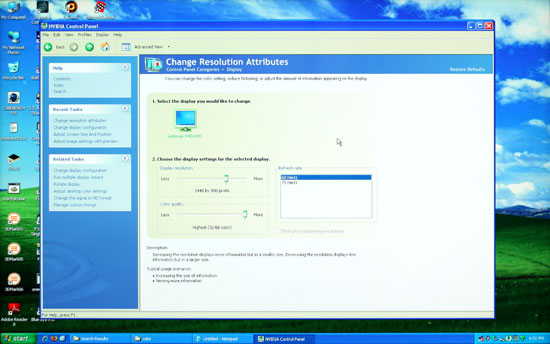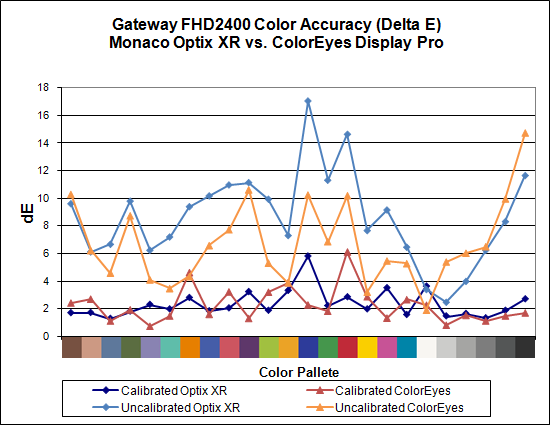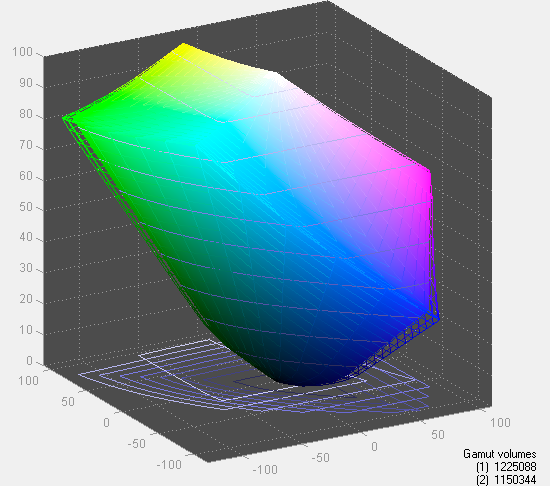Gateway FHD2400 Evaluation
The Gateway OSD remains largely unchanged since last Gateway LCD we reviewed -- the Gateway FPD2485W. It worked well over a year ago and it continues to work well today. Gateway uses a touch-sensitive buttons system on the right side of the LCD, but rather than leaving you to guess where to press, all of the active buttons light up as soon as you press the menu button. Our only complaint is that there are areas where Gateway could make better use of the buttons.
As an example, when you first activate the menu there are six buttons plus an additional two buttons up top that cycle through the color presets. These six buttons allow you to jump directly to one of several areas. Once you enter the Main menu, however, you then have to use the top two buttons to move up and down with the third button functioning as a select key. Granted, there are eight options in the main menu, but two of these (Auto and Reset) could easily be moved to a submenu. As a whole, though, this is a minor complaint on an OSD setup that works well.
Gateway includes seven color presets, one of which is "User" and allows manual adjustment of the color levels. Gateway also includes support for RGB and YUV color spaces. Also of interest is the "UltraResponse" function that supposedly improves pixel response times -- not that we could really tell. Gateway claims 3ms with UltraResponse enabled versus 5ms without UltraResponse.
The FHD2400 has four aspect ratio options: Wide, Zoom, 1:1, and Panoramic. "Panoramic" scaling only shows up with component (and perhaps other analog video connections), but then it just seems to do the same thing as "Wide". "Wide" fills the entire LCD with your current resolution, while "Zoom" fills the height or width while maintaining the correct aspect ratio. "1:1" is again a direct-mapped mode without any stretching. Here's a summary of our resolution testing:
| Gateway FHD2400 Resolution and Input Notes | ||||
| Component | DVI | HDMI | VGA | |
| 800x600 | Yes | Yes | Yes | |
| 1024x768 | Yes | Yes | Yes | |
| 1152x864 | Yes | Yes | Yes | |
| 1176x664 | Underscanned 720P | - | Underscanned 720P | - |
| 1280x720 | Yes | Yes | Yes | Yes |
| 1280x768 | Yes | Wrong AR (1280x1024) Use "Zoom" scaling |
Yes | |
| 1280x800 | - | Wrong AR (1280x1024) Use "Zoom" scaling |
- | |
| 1280x960 | Yes | Yes | Yes | |
| 1280x1024 | Yes | Yes | Yes | |
| 1400x1050 | - | Yes | - | |
| 1440x900 | Yes | Yes | Yes | |
| 1600x1200 | Yes | Wrong AR Always fills LCD ("Zoom") |
Yes | |
| 1680x1050 | Yes | Yes | Yes | |
| 1768x992 | Underscanned 1080i | - | Underscanned 1080P | - |
| 1920x1080 | Too much flicker | Yes | Yes | Yes |
| 1920x1200 | - | Yes | Yes | Yes |
First, let's get this out of the way: the component connection is only really suitable for 720P or 1080i signals. In general, the 720P option looks much better -- the opposite of the 2408WFP when using a component connection. All resolutions with more than 720 scanlines show severe flicker on component, as they run 60Hz interlaced. The other tested input options all work much better. VGA and DVI achieve a perfect score on all of the available resolutions, with no scaling abnormalities. Also worth mentioning is that the "Auto adjust" function on VGA is very fast. HDMI input has a few errors that you can work around by manually selecting "Wide" scaling; only 1600x1200 as an uncorrectable error in that it always fills the entire LCD, regardless of what scaling mode you choose.
 |
Running at non-native resolution, the FHD2400 does well at scaling the image to fit the panel and there are no serious artifacts. Obviously, 1920x1200 is still the optimal setting, but if you need to play a game or watch a movie at a lower resolution, you shouldn't have any complaints.


Besides limited viewing angles -- which are a problem on all TN panels today -- the one sticking point with the Gateway FHD2400 is color accuracy. After calibration, it achieves an average Delta E of only 2.3, which puts it in last place among tested LCDs. Uncalibrated color accuracy is also quite poor, coming in at 8.6 with plenty of colors above 10.0. Imaging professionals will almost certainly want something better. The good news is that the color gamut is good, achieving over 95% of the Adobe RGB 1998 standard.
The Gateway FHD2400 is sort of the opposite of the Dell 2408WFP. The Dell offers the absolute worst input lag but has by far and away the best color accuracy. The FHD2400 doesn't suffer from input lag at all, but unfortunately it has some of the worst color accuracy among tested LCDs. It's still a beautiful looking LCD, and it gets so many things right that we have no qualms recommending it to non-imaging professionals. That goes double if you'd like glossy LCD panels.
















89 Comments
View All Comments
Rasterman - Friday, May 9, 2008 - link
Yeah the figures reported are meaningless, if they were actually useful we wouldn't even need reviews :) I can't believe that a company as big as Viewsonic doesn't send a review site as big as Anandtech a review model, that is just ridiculous, they should be sending you guys a new model of every new monitor without even asking, maybe you aren't emailing the right person. BTW its awesome to see a reviewer actually answer questions and critics to a review, awesome job Jarred!JarredWalton - Friday, May 9, 2008 - link
I'm sure I'm not getting the right person at Viewsonic (and other companies as well), but that's the trick: *finding* the right person. Without an inside contact, it can be tough to get started.Generic PR Person: "AnandTech? What kind of a name is that? http://www.homestarrunner.com/sbemail50.html">Baleeted!" I'll try to meet with them next CES or something....
PS - Anyone from Viewsonic read this? If so, email me! :-)
10e - Tuesday, May 6, 2008 - link
Great review. This is what multifunction fans are looking for. I had this issue a year ago trying to find "THE" multifunction.You may want to mention that in terms of 720p and 1080p the Samsung stretches both to 16:10 with A/V mode off. I tested this and found that problem recently, which was unfortunate due to the fact that I liked it as a high quality TN.
JarredWalton - Tuesday, May 6, 2008 - link
I mentioned this on page 11, but I have highlighted (italicized) the pertinent text. I also clarified by indicating that 16:9 modes will always have the wrong AR. Thanks for reading and commenting!xerces8 - Monday, May 5, 2008 - link
A picture says more than 1000 words :http://www.digitalversus.com/duels.php?ty=6&ma...">http://www.digitalversus.com/duels.php?...2=49&...
(I can't create a link, seems the post javascript is broken, I cant make bold or italics text either, tried FF and IE7)
JarredWalton - Monday, May 5, 2008 - link
You mean, http://www.digitalversus.com/duels.php?ty=6&ma...">pictures like this one? I don't see any large blowups of their comparisons available for download, so I have no idea exactly how they're testing. What I do know is that I provided images showing LaCie 324 and Dell 2408WFP clearly displaying a 40ms delay relative to an HP LP3065, and I've also provided a picture of the ASUS MK241H with a relative delay of 0ms relative to the same LCD.I've got nine other sample images from each of the tested monitors showing the evidence for my "input lag" conclusions. That's about as close to full disclosure as you'll get. All I get on that comparison you linked is a chart that apparently "proves" the ASUS MK241H has a 54ms average delay compared to a CRT, but then the same site lists the Dell 2408WFP as 69ms, the 2407WFP as 24ms, the LaCie as 41ms, and the Samsung 245T at 59ms. I got more or less the same result on the Dell 2407WFP and the LaCie 324, but nowhere near the same result on the MK241H, 2408WFP, and the 2493HM.
Again, you've got at least one clear sample of my results for each LCD. Sorry, but I have to question their results without better evidence.
Dashel - Monday, May 5, 2008 - link
Hi Jarred,Not sure if this is based on the same test or what but there is this:
http://www.behardware.com/art/imprimer/712/">http://www.behardware.com/art/imprimer/712/
Which looks to be the same graph and results. To me your results seem to make the most sense if the 2408 is very similar to the 2407WFP-HC, then the input lag should be close too I would guess. I'm hardly an expert just tryint to be logical.
The thing is I also see anecdotal claims of lag and people who have tested it getting in the 60ms range as well which leads me to wonder if there isnt some sort of defect or difference in some of the panels vrs others.
Example of a test by an owner:
http://www.hardforum.com/showpost.php?p=1032124531...">http://www.hardforum.com/showpost.php?p=1032124531...
I'd love to hear Dells thoughts on it as well as what and when their revision is due to hit.
JarredWalton - Monday, May 5, 2008 - link
I'd like to know what software people are using as timers. I tried about 10 different "timers" and discovered that a bunch are limited to the Windows default timing resolution - about 54ms. So they either scored "0ms" or "54ms" on the delay. I know this because I had screen refreshes where the timer was split in half; the top half would show for example 40.067 and the bottom would show 50.121.3DMark03 at least looks to be accurate down to 10ms - there are again pictures where the timer is cut in half, only in such cases I would see 20.23 and 20.24, so I can be sure that the timer is updated in .01s increments rather than in something larger.
Without a lot more details about what software people use and large images showing the results, I must say that I'm very skeptical. I feel "input lag" testing needs several things to be even remotely acceptable:
1) Run at native LCD resolution in clone mode (because built-in scalers could have an impact)
2) Disclosure of the test software that manages better than 54ms accuracy.
3) You need a high-end camera with a fast shutter speed to capture the results. Simply choosing "Auto" mode and snapping a picture doesn't tell the whole story.
4) Provide at least one sample image at a high resolution that clearly shows what the camera captured.
I met all of those criteria I think. In looking around at other reviews, I have not been able to clearly answer any of those questions. Perhaps that's why some of the other results are so different. I also tested at 2560x1600 to verify that I wasn't hurting the HP LP3065 by running at a lower resolution; since the scaling is handled by the GPU rather than the LCD (the LP3065 doesn't have a scaler), there was no penalty.
DangerousQ - Monday, May 5, 2008 - link
I cant believe this set of reviews is so one sided, why no P-MVA panels, I bought a BenQ FP241W about 3 monyths ago and the 6ms response time plus unbelievable colours make this panel really hard to beat, but you try finding any reviews on it. The one review I did find, a long time ago and have lost it now compared it to the 2407 dell and found it a better panel for less money! I know this cos I was going to buy the dell before I saw the review.JarredWalton - Monday, May 5, 2008 - link
Send me an MVA panel - or get one of the manufacturers to send me one - and I will be more than happy to review it. I don't have the means to go out and purchase $500+ test LCDs, so I review what I get sent. Dell, Gateway, Samsung, ASUS, and other major companies are great about working with review sites like ours. Other companies are not. Thus, I take what I can get.